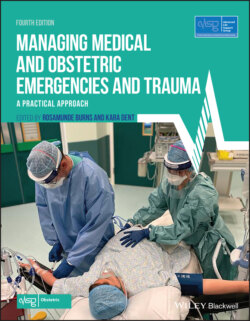Читать книгу Managing Medical and Obstetric Emergencies and Trauma - Группа авторов - Страница 94
ABG interpretation
ОглавлениеNormal values for both the non‐pregnant and the pregnant state are given in Table 5A.1. To interpret a blood gas, review the following:
Check PaO2 (normal values 11–13 kPa ON AIR): if it is low, then the patient is hypoxaemic
Check the pH value: to determine the direction of primary change (normal, acidosis or alkalosis); compensation is always incomplete
Check PaCO2, which is determined by breathing (alveolar ventilation): a low PaCO2 (hyperventilation) indicates a respiratory alkalosis or respiratory compensation for a metabolic acidosis; a raised PaCO2 (hypoventilation) indicates respiratory acidosis – note that PaCO2 does not rise to compensate for a metabolic alkalosis
Check standard bicarbonate (the bicarbonate value adjusted to what it would have been if the PaCO2 were normal): if the standard bicarbonate is raised then there is either a metabolic alkalosis or metabolic compensation for a respiratory acidosis; if the standard bicarbonate is low then there is either a metabolic acidosis or metabolic compensation for a respiratory alkalosis
Check base excess: if it is negative then there is a metabolic acidosis; if it is positive then there is a metabolic alkalosis
Table 5A.1 Blood gases in non‐pregnant and pregnant women
| pH | PaCO2 | Standard bicarbonate | Base excess | ||
|---|---|---|---|---|---|
| Normal values | 7.34–7.44 | 4.7–6.0 kPa | 21–27 mmol/l | –2 to +2 mmol/l | |
| Values in pregnancy | 7.40–7.46 | 3.7–4.2 kPa | 18–21 mmol/l | No change | |
| Increased | Decreased | Decreased | |||
| Respiratory acidosis | ↓ | ↑ | ↑ | +ve | Hypoventilation leading eventually to compensatory renal retention of bicarbonate |
| Respiratory alkalosis | ↑ | ↓ | ↓ | –ve | Hyperventilation leading to renal excretion of bicarbonate |
| Metabolic acidosis | ↓ | ↓ | ↓ | –ve | Excess metabolic acid leading to respiratory hyperventilation to compensate Raised lactate in most types of shock |
| Metabolic alkalosis | ↑ | ↑ | +ve | Excess metabolic alkali but no respiratory compensation compensation |
